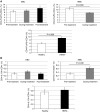The effects of trastuzumab on the CD4+CD25+FoxP3+ and CD4+IL17A+ T-cell axis in patients with breast cancer
- PMID: 19277040
- PMCID: PMC2670001
- DOI: 10.1038/sj.bjc.6604963
The effects of trastuzumab on the CD4+CD25+FoxP3+ and CD4+IL17A+ T-cell axis in patients with breast cancer
Abstract
In addition to the direct targeting effects on HER2-positive cells, trastuzumab may have a therapeutic role modulating the activity of the cellular immune system in patients with breast cancer. To investigate this further, the balance of T-regulatory (T(reg)), Th17, natural killer (NK) and NK T (NKT) cells before, during and after trastuzumab therapy was investigated. Sequential frequencies of circulating T(reg) cells, Th17 cells, NK and NKT cells were measured in peripheral blood of breast cancer patients and normal controls throughout therapy. Individuals with breast cancer had significantly higher T(reg) frequencies of peripheral blood compared with healthy controls (9.2 or 8.6 vs 6%; P<0.05), and no significant differences in T(reg) frequencies were observed between HER2-positive and HER2-negative individuals. The number of Th17 cells was lowest in HER2-positive patients compared with both healthy controls and HER2-negative patients (0.31 vs 0.75% or 0.84%; P=0.01). There appeared to be an inverse relationship between T(reg) and Th17 frequencies in metastatic breast cancer (MBC) with T(reg) levels significantly reduced during treatment with trastuzumab (P=0.04), whereas Th17 frequencies were concomitantly increased (P=0.04). This study supports earlier data that T(reg) cells are present at higher frequencies in breast cancer patients compared with healthy individuals. For the first time, we show that HER2-positive individuals with breast carcinomas have reduced numbers of circulating Th17 cells, which appear, in turn to have an inverse relationship with T(reg) frequency in MBC. The change in balance of the T(reg) : Th17 ratio appears to characterise the cancer state, and furthermore, is disrupted by trastuzumab therapy.
Figures





References
-
- Bamias A, Koutsoukou V, Terpos E, Tsiatas ML, Liakos C, Tsitsilonis O, Rodolakis A, Voulgaris Z, Vlahos G, Papageorgiou T, Papatheodoridis G, Archimandritis A, Antsaklis A, Dimopoulos MA (2008) Correlation of NK T-like CD3+CD56+ cells and CD4+CD25+(hi) regulatory T cells with VEGF and TNFalpha in ascites from advanced ovarian cancer: Association with platinum resistance and prognosis in patients receiving first-line, platinum-based chemotherapy. Gynecol Oncol 108: 421–427 - PubMed
-
- Beyer M, Schultze JL (2006) Regulatory T cells in cancer. Blood 108: 804–811 - PubMed
-
- Davidson TS, DiPaolo RJ, Andersson J, Shevach EM (2007) Cutting edge: IL-2 is essential for TGF-beta-mediated induction of Foxp3+ T regulatory cells. J Immunol 178: 4022–4026 - PubMed
MeSH terms
Substances
LinkOut - more resources
Full Text Sources
Medical
Research Materials
Miscellaneous

